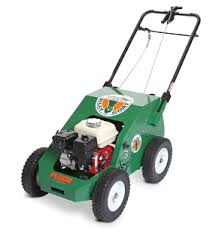Which aerator design is best? Drum aerators remain popular, but newer designs provide superior performance and are a lot easier to use. What are the differences, and which one is right for you?
Drum Aerators
The oldest type of aerator, this piece of equipment looks like a carpet roller covered in tines. This design limits the amount of holes that can be made to between 4-6 per square foot. The tines are mounted on a system that can retract into the drum, separating the aerator for the soil. While it’s possible to lift push aerators out of the ground, in most cases the tines need to be retracted to make turns.
A lot of weight is needed to get tines to penetrate the soil, but by the nature of their design, the amount of weight that can be put on the drum is limited. This makes it much harder to penetrate any soil that isn’t damp, reducing the effectiveness of the aeration. Towable drum aerators can be heavier, but they still run into the same problems when turning, making them a pain to use.
Reciprocating Aerators
These are sometimes called “cam” aerators because they use a cam mechanism to move the tines back and forth. This cam looks a lot like an engine crankshaft with shafts and tines replacing the rods and pistons. The engine spins the cam, forcing the tines into the soil instead of depending only on the weight of the aerator. That makes these machines a lot lighter than a drum aerator and it helps the machine get consistent penetration with a variety of soils.
The number of tines is also significantly lower, which simplifies maintenance. Billy Goat’s AE and PLUGR models use 4 or 8 tines instead of the dozens needed for a similarly sized drum aerator. It also means there’s less chance of damage, eliminating the wear and vibration of a drum. Add in a powerful engine and drive system, and a reciprocating aerator cut job times by up to 50%. This design is limited in size to walk-behind units, limiting their use to small lawns.
Towable Tine Wheel Aerators
Tine wheel-based aerators like Billy Goat’s towable AET models share some features with drum aerators, but since they’re backed by the power of a tractor, it’s easy to work around the drum’s problems to create a trailer that can cover large spaces quickly with minimal effort.
With this design, weight is only an issue for transport, so Billy Goat’s AET series aerators are designed to use removable blocks, sandbags or water-filled jugs to push down the tines when the trailer is in use. Once the work is done, these weights can be removed so it’s easier to load the attachment onto a trailer. This eliminates the need for a heavy drum that surrounds the tines.
Billy Goat’s AET can lift the tine wheels together as a unit using a built-in manual lift. This eliminates the need for a retracting tine system, significantly improving serviceability. The 36/60” model has swiveling tine bodies that can move with the tractor if a three point hitch is being used, so there’s no need to raise the tines through turns.
The 48/72” uses a chain drive system driven by the wheels as the unit is towed, increasing the speed of the tine stars. This results in a denser hole pattern than what can be achieved with a drum aerator.
Get the Parts You Need to Keep Your Billy Goat Working
Need some tines or other parts for your Billy Goat aerator? www.billygoatpart.com is a certified Billy Goat dealer, so we can supply you with everything you need to keep your equipment moving. Our site has built in parts diagrams and descriptions to make it easy to find what you need, and we can ship your order to any location in the U.S. or Canada.

